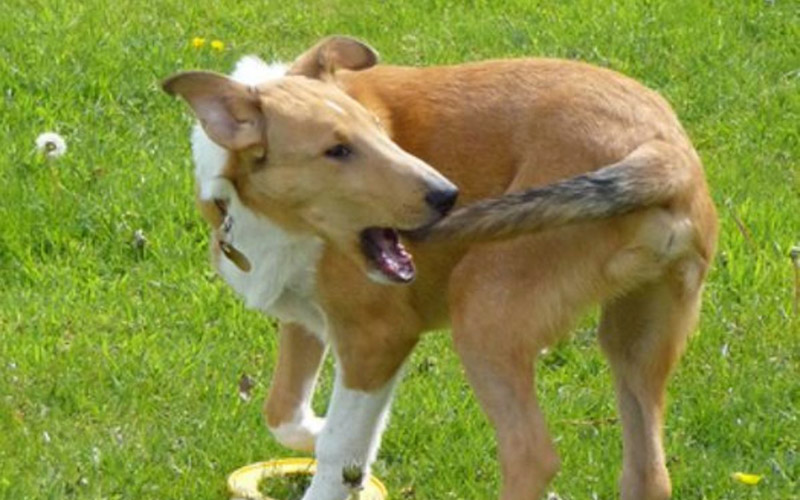Is your dog obsessed with his tail? Does he chase, chew, or nip at it constantly? If so, you may be wondering why he does that and how you can help him. In this article, we explore the reasons behind tail biting in dogs and how to help your furry friend.

Common Causes of Dog Tail Biting
There are many possible causes of dog tail biting, ranging from physical to psychological. Here are some of the most common ones:
Allergies
Dogs can develop allergies to various substances, such as food, pollen, dust, or chemicals. These allergies can cause itching, inflammation, and irritation on the skin, including the tail area. Your dog may bite his tail to relieve the itchiness or discomfort. Some signs of allergies in dogs are:
- Redness, swelling, or rash on the skin
- Excessive scratching, licking, or chewing
- Hair loss or bald patches
- Ear infections or discharge
- Sneezing, coughing, or wheezing
Fleas and Ticks
Fleas and ticks are external parasites that feed on your dog’s blood and can cause severe itching, irritation, and infection. They can also transmit diseases, such as Lyme disease or Rocky Mountain spotted fever. Your dog may bite his tail to get rid of the pests or to soothe the itchiness. Some signs of fleas and ticks in dogs are:
- Visible fleas or ticks on the fur or skin
- Flea dirt (black specks) or tick eggs (white dots) on the fur or bedding
- Scabs, sores, or crusts on the skin
- Anemia (low red blood cell count) or fever
Boredom and Anxiety
Dogs are social animals that need mental and physical stimulation to stay happy and healthy. If your dog is bored, lonely, or stressed, he may develop behavioral problems, such as tail biting. Tail biting can be a way of coping with boredom or anxiety, or a form of self-soothing or self-harm. Some signs of boredom and anxiety in dogs are:
- Destructive behavior, such as chewing, digging, or barking
- Restlessness, pacing, or whining
- Separation anxiety, such as crying, howling, or escaping when left alone
- Aggression, fear, or nervousness
Pain or Injury
Dogs can experience pain or injury in their tails due to various reasons, such as trauma, infection, arthritis, or cancer. Your dog may bite his tail to alleviate the pain or to draw attention to the problem. Some signs of pain or injury in dogs are:
- Limping, stiffness, or difficulty moving
- Loss of appetite, weight, or energy
- Changes in behavior, mood, or personality
- Swelling, bleeding, or discharge from the tail
Anal Gland Issues
Anal glands are small sacs located near the anus that secrete a smelly fluid to mark territory and communicate with other dogs. Sometimes, these glands can become blocked, infected, or inflamed, causing pain, discomfort, and odor. Your dog may bite his tail to try to empty or clean the glands or to ease the pain. Some signs of anal gland issues in dogs are:
- Scooting, dragging, or licking the rear end
- Foul-smelling or bloody discharge from the anus
- Swelling, redness, or abscess near the anus
- Difficulty defecating or constipation
When to See a Vet
If your dog is biting his tail excessively or persistently, you should consult your veterinarian as soon as possible. Your vet can examine your dog and determine the cause of the tail biting and the best course of treatment. Some of the possible treatments are:
- Antihistamines, steroids, or immunotherapy for allergies
- Flea and tick prevention and treatment
- Behavioral modification, enrichment, or medication for boredom and anxiety
- Pain relief, anti-inflammatory, or surgery for pain or injury
- Anal gland expression, antibiotics, or surgery for anal gland issues

How to Help Your Dog Stop Biting His Tail
Depending on the cause of the tail biting, there are some things you can do to help your dog stop biting his tail and prevent further damage or infection. Here are some tips:
Address the Underlying Cause
The most important thing is to address the underlying cause of the tail biting, whether it is physical or psychological. Follow your vet’s advice and provide the appropriate treatment for your dog’s condition. This may include medication, supplements, diet changes, or grooming.
Provide Enrichment Activities
To prevent boredom and anxiety, you should provide your dog with enough exercise, play, and socialization. Make sure your dog has a daily routine of walks, games, and training. You can also offer your dog interactive toys, puzzles, or chews to keep him busy and entertained.
Manage Anxiety
If your dog suffers from anxiety, you should try to identify and avoid the triggers that cause him stress, such as loud noises, strangers, or separation. You can also create a safe and comfortable environment for your dog, such as a crate, bed, or blanket. You can also use calming aids, such as music, aromatherapy, or pheromones, to help your dog relax.
Visit the Vet for Treatment
If your dog’s tail biting is severe or does not improve with home remedies, you should visit your vet for further treatment. Your vet may prescribe medication, such as antibiotics, anti-inflammatory, or anti-anxiety, to help your dog heal and cope. Your vet may also recommend a cone, bandage, or bitter spray to prevent your dog from biting his tail.

Conclusion
Tail biting in dogs can be a sign of various physical or psychological issues, such as allergies, fleas, boredom, or pain. It is important to consult your vet and address the underlying cause of the tail biting and provide the appropriate treatment. You can also help your dog stop biting his tail by providing enrichment, managing anxiety, and visiting the vet for treatment.
